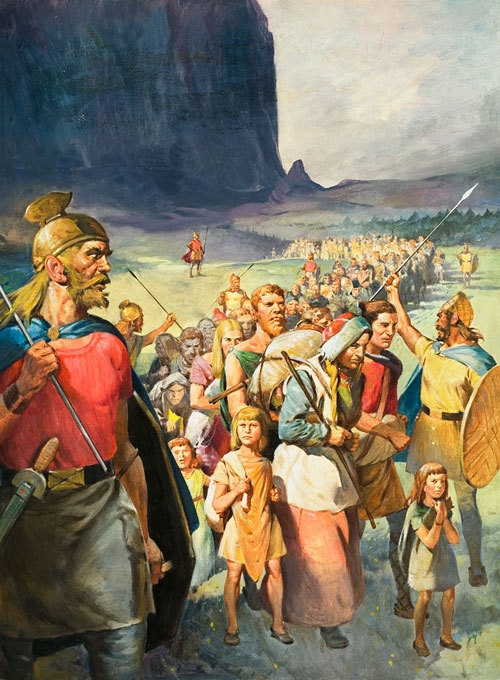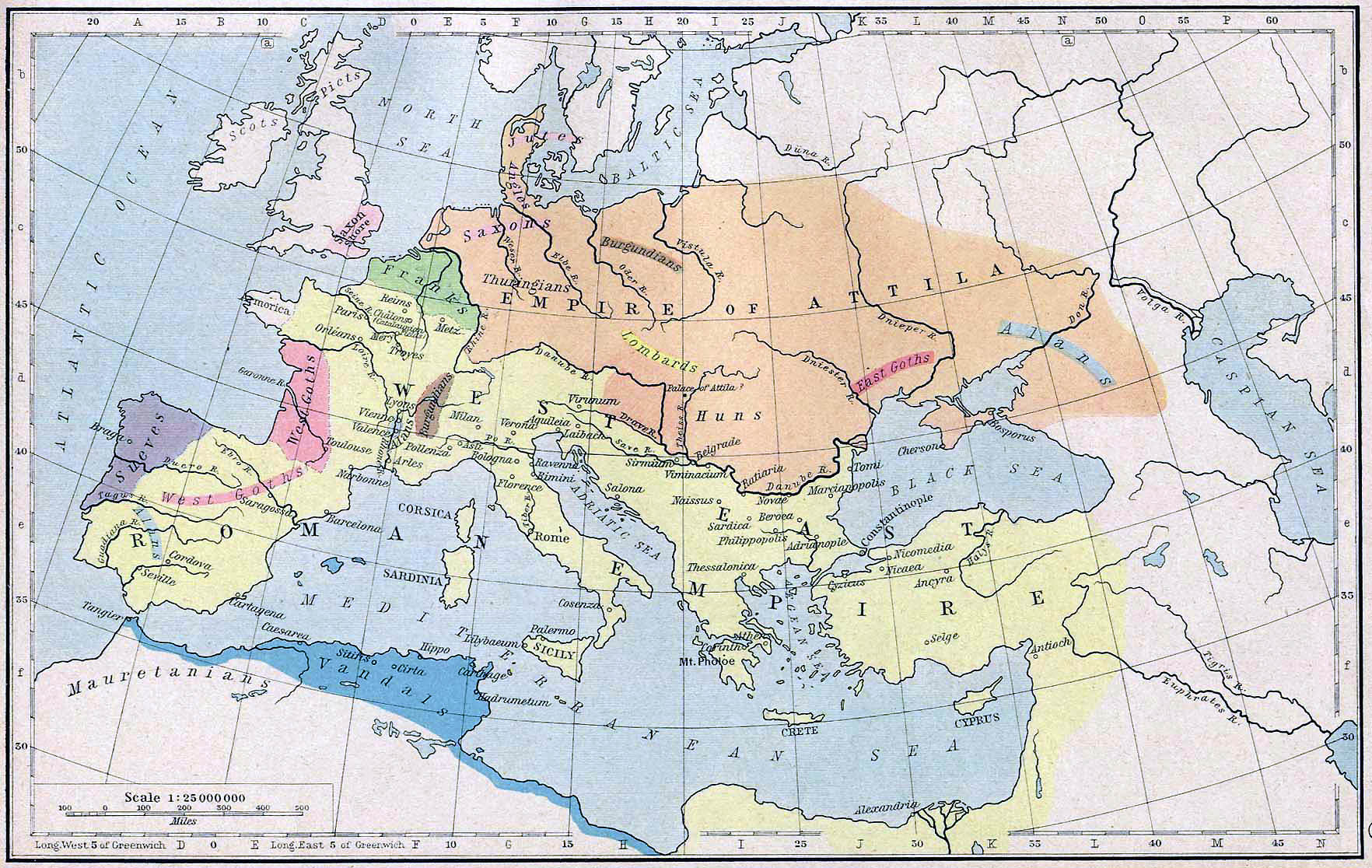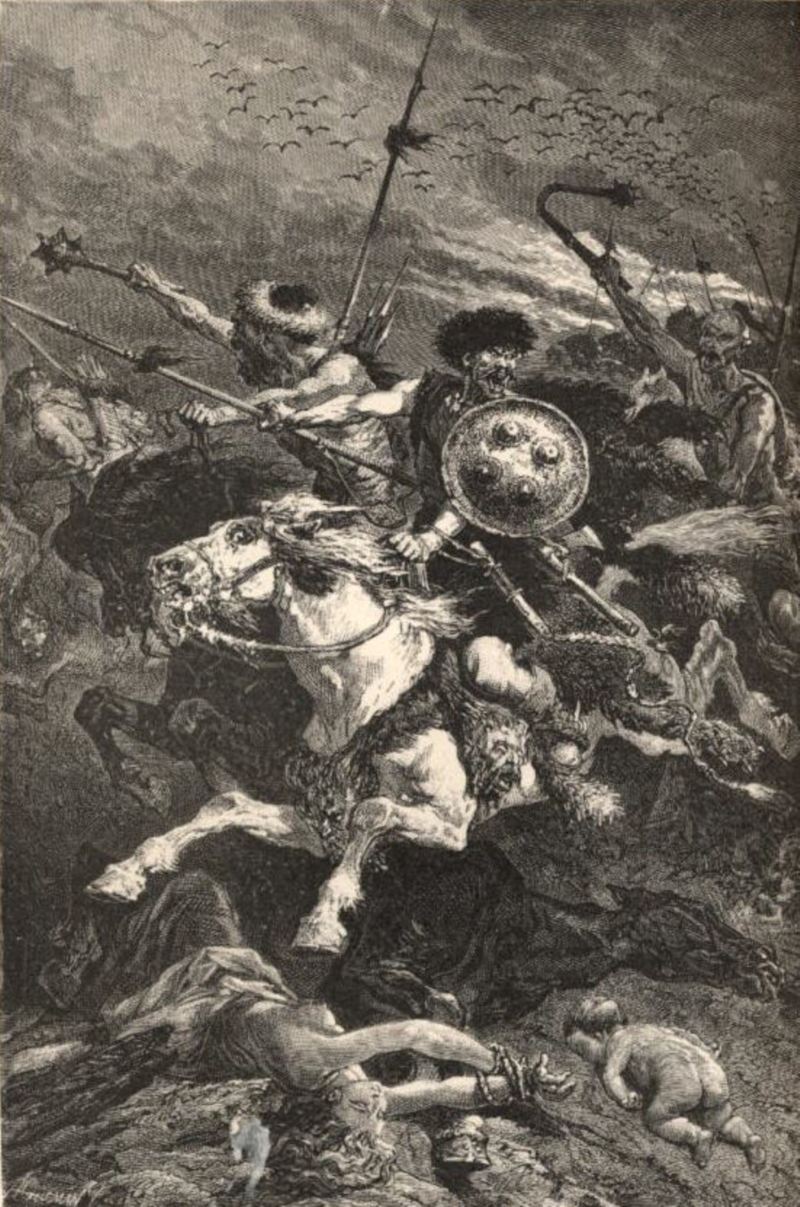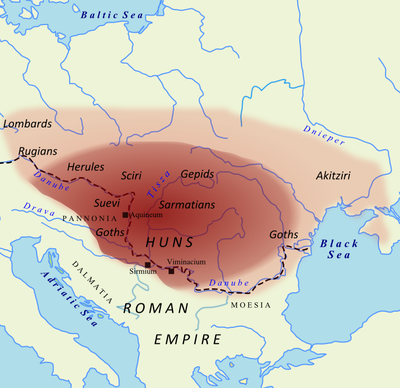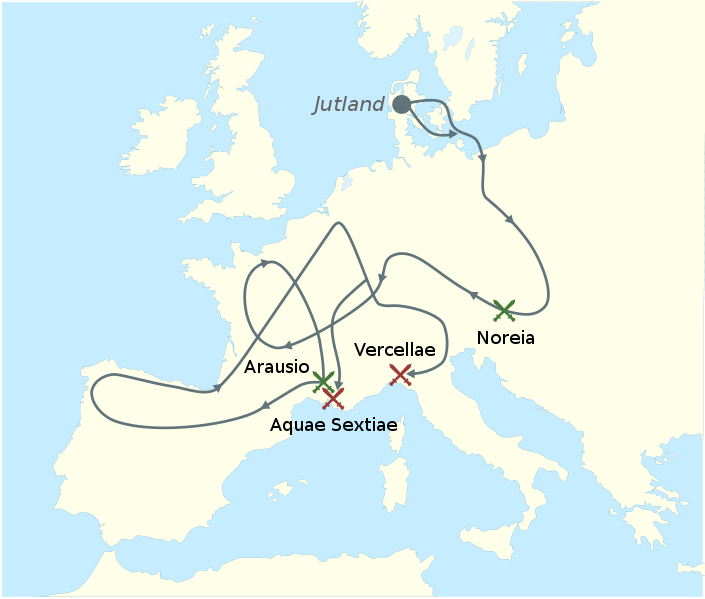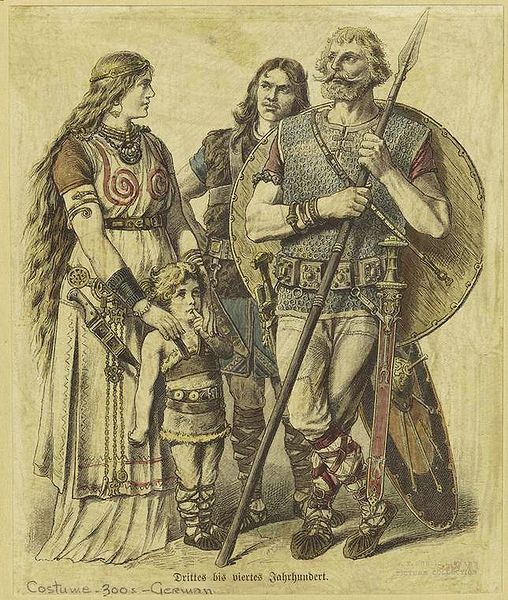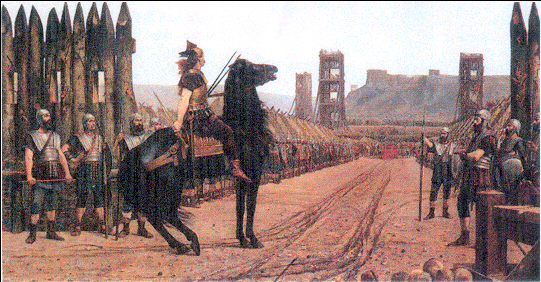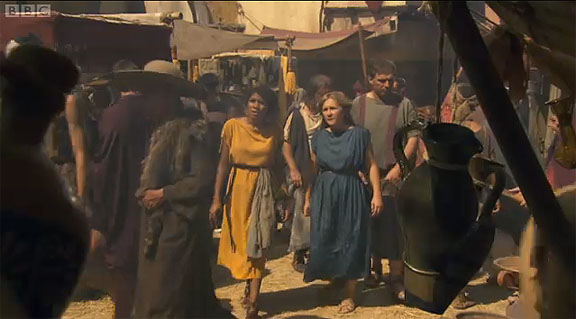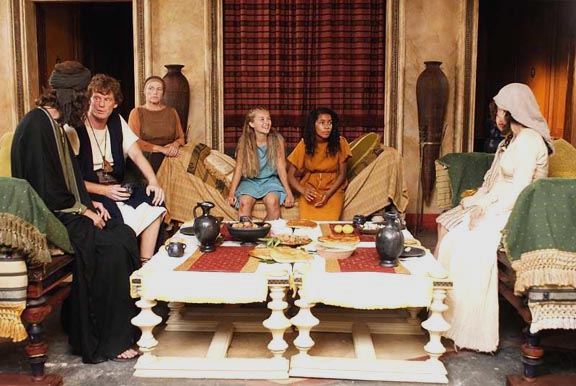Category: Demography
Excerpted from the 17th article of William Pierce’s “Who We Are: a Series of Articles on the History of the White Race”:
The Huns halted their westward push for more than 40 years while they consolidated their hold on all of central and eastern Europe, and on much of northern Europe as well. In 433 they gained a new king, whose name was Attila. In 445, when Attila established his new capital at Buda, in what is now Hungary, the empire of the Huns stretched from the Caspian Sea to the North Sea.
In 451 Attila began moving west again, with the intention of seizing Gaul and then the rest of the Western Empire. His army consisted not only of Huns but also of contingents from all the conquered peoples of Europe: Ostrogoths, Gepids, Rugians, Scirians, Heruls, Thuringians, and others, including Slavs.
One contingent was made up of Burgundians, half of whom the Huns had subjugated (and nearly annihilated) in 436. The struggle between the Burgundians and the Huns forms the background for the German heroic epic, the Nibelungenlied.
Scourge of God
Attila’s mixed army threw western Europe into a state of terror as it advanced. So great was the devastation wrought on the countryside that Attila was given the nickname “the Scourge of God,” and it was said that grass never again grew where his horse had trod.
Two armies, one commanded by Aëtius, the last of the Western Empire’s Roman generals, and the other by Theodoric, King of the Visigoths, rode against Attila. Aëtius and Theodoric united their armies south of the Loire, in central Gaul, and compelled Attila to withdraw to the north-east.
Attila carefully chose the spot to halt his horde and make his stand. It was in a vast, open, and nearly level expanse of ground in northeastern France between the Marne and the Seine, where his cavalry would have ideal conditions for maneuvering. The region was known as the Catalaunian Plains, after the Catalauni, a Celtic people. The name of Chalons (ancient Catalaunum), is most often associated with the battle which took place on the Catalaunian Plains, although the actual site is much closer to the city of Troyes.
White Victory
In a furious, day-long battle frightful losses were inflicted on both sides, but the Visigoths, Franks, free Burgundians, and Alans of Aëtius and Theodoric had gained a decisive advantage over the Huns and their allies by nightfall. Attila retreated behind his wagons and in despair ordered a huge funeral pyre built for himself. He intended neither to be taken alive by his foes nor to have his corpse fall into their hands.
King Theodoric had fallen during the day’s fighting, and the command of the Visigothic army had passed to his son, Thorismund. The latter was eager to press his advantage and avenge his father’s death by annihilating the Hunnic horde.
Empire of Attila (orange) by 450 A.D.
The wily Roman Aëtius, however, putting the interests of his dying Empire first, persuaded Thorismund to allow Attila to withdraw his horde from Gaul. Aëtius was afraid that if Thorismund completely destroyed the power of the Huns, then the Visigoths would again be a menace to the Empire; he preferred that the Huns and the Visigoths keep one another in check.
Battle of the Nedao
Attila and his army ravaged the countryside again, as they made their way back to Hungary. The following year they invaded northern Italy and razed the city of Aquileia to the ground; those of its inhabitants who were not killed fled into the nearby marshes, later to found the city of Venice.
But in 453 Attila died. The 60-year-old Hun burst a blood vessel during his wedding-night exertions, following his marriage to a blonde German maiden, Hildico (called Kriernhild in the Nibelungenlied). The Huns had already been stripped of their aura of invincibility by Theodoric, and the death of their leader diminished them still further in the eyes of their German vassals.
The latter, under the leadership of Ardaric the Gepid, rose up in 454. At the battle of the Nedao River in that year it was strictly German against Hun, and the Germans won a total victory, completely destroying the power of the Huns in Europe.
Slavic Opportunity
The vanquished Huns fled eastward, settling finally around the shores of the Sea of Azov in a vastly diminished realm. They left behind them only their name, in Hungary. Unfortunately, they also left some of their genes in those parts of Europe they had overrun. But in 80 years they had turned Europe upside down. Entire regions were depopulated, and the old status quo had vanished.
This provided an opportunity for the Slavs to expand, and they took advantage of it, as mentioned earlier. Unfortunately for them—and for our entire race—the area into which the Slavs expanded corresponded largely to the area invaded repeatedly in later centuries by Asiatic hordes from the east, and the Slavic peoples suffered grievously. We will examine these Asiatic invasions in later installments.
Excerpted from the 17th article of William Pierce’s “Who We Are: a Series of Articles on the History of the White Race”:
The Gothic nation, as was mentioned in the previous installment, had established itself on the southern shore of the Baltic, around the mouth of the Vistula, before 300 B.C. Prior to that the Goths had lived in southern Sweden.
Conquest of the Steppe
The Goths west of the Dniester—the Visigoths—moved down into the Danubian lands west of the Black Sea, where they inevitably came into conflict with the Romans. They conquered the Roman province of Dacia for themselves, after defeating a Roman army and killing a Roman emperor (Decius) in the year 251.
For the next century and a quarter both the Visigoths and the Ostrogoths prospered, while the fortunes of the Roman Empire continued to decline. The Goths, who were excellent seamen, raided the Black Sea coastal cities of Asia Minor at will, and Rome was also hard pressed to defend other portions of her long border with the Germans.
Peaceful Coexistence
Toward the end of the third century, during the reign of Diocletian, the Empire was divided into eastern and western halves, for administrative and military purposes. The progressive breakdown of communications led eventually to separate de facto powers, one centered in Rome and the other in Byzantium (later renamed Constantinople).
During the first three-quarters of the fourth century, despite occasional raids, a state of relatively peaceful coexistence between Goths and Romans pervaded. Especially in the eastern half of the Empire, diplomacy and bribery were used to hold the Goths at bay. During the reign of Constantine (306-337) 40,000 Goths were recruited into the Roman army, and they thenceforth were the bulwark of the Eastern Empire.
It was in the reign of Emperor Valens, in the year 372, that the greatest menace to the White race, both Germans and Romans, since the beginning of recorded history suddenly appeared on the eastern horizon. From the depths of Central Asia a vast horde of brown- skinned, flat-nosed, slant-eyed little horsemen—fast, fierce, hardy, bloodthirsty, and apparently inexhaustible in numbers—came swarming across the steppe around the north end of the Caspian Sea. They were the Huns.
The first to feel their impact were the Alans, living south of the Don between the Black Sea and the Caspian Sea. The Hunnic horde utterly crushed the Alans, some of whose remnants retreated southward into the Caucasus Mountains, while others fled westward in confusion, seeking refuge among the Goths. In the Caucasus today traces of the Nordic Alans are found in the Ossetes, whose language is Indo-European and who are taller and lighter than the Caucasic-speaking peoples around them.
End of the Ostrogoths
Next the Huns fell upon the Ostrogoths and routed them. The aged Ostrogothic king, Hermanric, slew himself in despair, and his successor, Vitimer, was killed in a vain effort to hold back the Brown flood. The Ostrogothic kingdom disintegrated, and its people streamed westward in terror, with the Huns at their heels. Athanaric, king of the Visigoths, posted himself at the Dniester with a large army, but the Huns crossed the river and defeated him, inflicting great slaughter on his army.
Thus, the Visigoths too were forced to retreat westward. Athanaric petitioned Valens for permission for his people to cross the Danube and settle in Roman lands to the south. Valens consented, but he attached very hard conditions, which the Goths, in their desperation, were forced to accept: they were required to surrender all their weapons and to give up their women and children as hostages to the Romans.
Oppression and Rebellion
The Goths crossed the Danube in 376 and settled in the Roman province of Lower Moesia, which corresponds roughly to modern Bulgaria. There the Romans took shameful advantage of them. Roman-Jewish merchants, in return for grain and other staples, took the hostage children of the Goths as slaves.
The Goths secretly rearmed themselves and rose up. For two years they waged a war of revenge, ravaging Thrace, Macedonia, and Thessaly. Finally, on August 9, 378, in the great battle of Hadrianople, the Gothic cavalry, commanded now by Fritigern, annihilated Valens’ infantry (most of whom were also Goths), and the emperor himself was killed. This was the worst defeat Rome had suffered since the Goths defeated and killed Decius 127 years earlier, and the battle decisively changed the conduct of future wars. Heretofore, Roman infantry tactics had been considered unbeatable, but Fritigern’s Goths had shown what heavy cavalry could do to infantry unprotected by its own cavalry.
The emperor of the eastern half of the Empire who succeeded Valens took a much more conciliatory stance toward the Goths, and they were confirmed in their possession of much of the territory south of the Danube which they had seized between 376 and 378. The Huns, meanwhile, had occupied Gothic Dacia (present-day Romania), as well as all the lands to the east.
Loss of a Homeland
The ancient homeland of the Nordic race was now in the hands of non-Whites. For more than four millennia wave after wave of White warriors had come out of the eastern steppe to conquer and colonize Europe: Achaeans, Dorians, Latins, Celts, Germans, Balts, Slavs, Cimmerians, Scythians, Sarmatians, and uncounted and unnamed peoples before all these. But the Sarmatians were the last; after the Huns drove them and the Goths out, no other White barbarians were to come riding out of the east.
For the next thousand years the eastern steppe which had been the breeding ground of the Nordic race became the invasion route into Europe for periodic waves of non-White hordes from Asia: Huns, Avars, Turks, Magyars, Mongols.
German vs. German
The Huns contented themselves, for the time being, with that portion of Europe between the Carpathians and the Danube, leaving the Romans and the Germans elsewhere to their own devices. Rome, a hollow shelf peopled largely by Levantines and ruled in effect by a gaggle of filthy-rich Middle Eastern moneylenders, speculators, and merchants, depended for her continued existence upon cleverness and money rather than real strength. Germans menaced her and Germans defended her, and the Romans concentrated their energies on playing German off against German.
The game succeeded in the Eastern Empire, more or less, but not in the Western Empire. A Frank, Arbogast, was the chief adviser—and effective master—of Western Emperor Eugenius in the year 394, having assassinated Eugenius’ predecessor. The emperor of the East, Theodosius, sent his Gothic army against Arbogast, and Arbogast called on his fellow Franks for support. The two German armies fought at Aquileia, near modern Venice, and the Goths defeated the Franks.
Alaric the Bold
Two of the leaders of Theodosius’ army were Alaric the Bold, a Gothic prince, and Stilicho, a Vandal. After the battle of Aquileia Stilicho, nominally subordinate to Theodosius, became the effective master of the Western Empire. Alaric was chosen king of the Visigoths by his tribe and decided to challenge Stilicho, but as long as Stilicho lived he was able to hold Alaric at bay.
The emasculated and Levantinized Romans, unable to face the Germans man to man, bitterly resented their German allies as much as they did their German enemies. This resentment, born of weakness and cowardice, finally got the better of the Romans in 408, and they conspired to have their protector, Stilicho, murdered. Then the Romans in all the Italian cities butchered the wives and children of their German allies—60,000 of them.
This foolish and brutal move sent Stilicho’s German soldiers into Alaric’s arms, and Italy was then at the Goth’s mercy. Alaric’s army ravaged large areas of the peninsula for two years in revenge for the massacre of the German families. Alaric demanded a large ransom from the Romans and forced them to release some 40,000 German slaves.
Fall of Rome
Then, on the night of August 24, 410, Alaric’s Goths took Rome and sacked the city. This date marked, for all practical purposes, the end of the capital of the world. Rome had endured for 1,163 years and had ruled for a large portion of that time, but it would never again be a seat of power. For a few more decades the moribund Empire of the West issued its commands from the fortress city of Ravenna, 200 miles north of Rome, until the whole charade was finally ended in 476. The Empire of the East, on the other hand, would last another thousand years.
Excerpted from the 15th and 16th articles of William Pierce’s “Who We Are: a Series of Articles on the History of the White Race”:
The philosopher Lucius Annaeus Seneca, also writing in the first century, shared Tacitus’ respect for the Germans’ martial qualities: “Who are braver than the Germans? Who more impetuous in the charge? Who fonder of arms, in the use of which they are born and nourished, which are their only care?”
Caesar, Tacitus, and other writers also described other attributes of the Germans and various aspects of their lives: their shrines, like those of the Celts and the Balts, were in sacred groves, open to the sky; their family life (in Roman eyes) was remarkably virtuous, although the German predilection for strong drink and games of chance must have been sorely trying to wives; they were extraordinarily hospitable to strangers and fiercely resentful of any infringements on their own rights and freedoms; each man jealously guarded his honor, and a liar was held in worse repute than a murderer; usury and prostitution were unknown among them.
[Here Pierce recounts the clash between the Germanics and the Romans under Caesar, Augustus and Tiberius. Then he adds:]
Five Decisive Things
During the 401 years between Hermann’s victory in the Teutoburger Forest and the sacking of the city of Rome by a German army in August 410, a great many things of historical importance occurred. We will be able to look at only a few of them in detail, however; we do not want to be distracted from our history of the race by the minutiae of political history, no matter how important.
Five things which happened or were ongoing during this period stand out as decisive, from a racial viewpoint. First, there was the continued decadence of the Romans, a matter we have already treated. Second, there was the growing Germanization of the Roman army. Third, there was the migration of the Goths from their home in Scandinavia back to the ancient Indo-European homeland in southern Russia. Fourth, there was the invasion of Europe by a non-White horde from the Far East: the Huns. And fifth, there was the final undermining of Roman strength by the spread of a new religion from the Levant—an Oriental religion of pacifism and egalitarianism which also began to have an effect on the Germans.
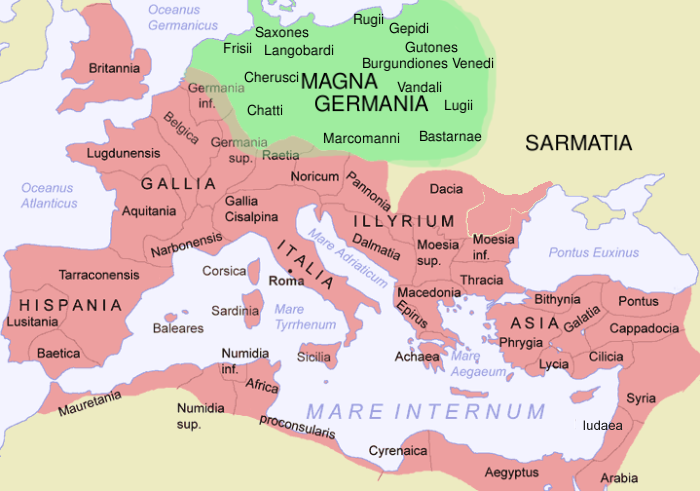 When Marcus Aurelius, the last Roman emperor able to inspire any real fear or respect in the Germans, tried to recruit troops to defend Rome’s Danubian border in 168, not even the threat of death induced Italians to enlist in the legions. The emperor finally resorted to conscripting all of Rome’s gladiators, most of whom were Celtic or German prisoners of war, into the army, whereupon the Roman masses, as addicted to their spectator sports as America’s masses are to their TV, threatened insurrection. “He deprives us of our amusements,” the populace cried out in anger against the emperor, “in order to make us philosophers like himself.” As they had become less martial, the Romans—or, rather, the Jews, Syrians, Egyptians and debased Greeks of the Empire who unworthily bore that once-honorable name—had grown ever more fond of the cruel blood sports of the Colosseum.
When Marcus Aurelius, the last Roman emperor able to inspire any real fear or respect in the Germans, tried to recruit troops to defend Rome’s Danubian border in 168, not even the threat of death induced Italians to enlist in the legions. The emperor finally resorted to conscripting all of Rome’s gladiators, most of whom were Celtic or German prisoners of war, into the army, whereupon the Roman masses, as addicted to their spectator sports as America’s masses are to their TV, threatened insurrection. “He deprives us of our amusements,” the populace cried out in anger against the emperor, “in order to make us philosophers like himself.” As they had become less martial, the Romans—or, rather, the Jews, Syrians, Egyptians and debased Greeks of the Empire who unworthily bore that once-honorable name—had grown ever more fond of the cruel blood sports of the Colosseum.
All-Volunteer Army
Until the end of the third century law prohibited the enlistment of foreigners in the Roman army. Although the law was often violated, it resulted in most of Rome’s soldiers being recruited from among the Celts and Germans of the conquered provinces during a period of about 150 years. By the time of Constantine not even the provinces could provide enough soldiers to defend the degenerate Roman Empire, and the greatest source of military manpower became the free Germans, who enlisted for purely mercenary motives.
By the middle of the fourth century, the Roman army was Roman in name only. Germans not only filled the ranks, but most of the officers, up to the highest levels of command, were Germans as well. Thus, the more or less continual state of war which existed between the free Germans and the Roman Empire during the third, fourth, and fifth centuries—up until 476, when the last Roman emperor was deposed and banished and a German leader ruled Italy as king—was not fought between Germans and Romans, but between Germans on the one side and Germans on the other.
Gold for Blood
The Romans bought their protection instead of fighting for it. Gold paid for blood for more than 200 years, but in the end all their money and their civilized cleverness were not enough.
If the Germans could have added a stronger sense of racial solidarity to their other virtues, they could have put an end to the sewer that was Rome 200 or even 300 years sooner than they did. They would not only have avoided spilling torrents of their own blood, but they could have stamped out a source of poison that, allowed to continue festering, ultimately would infect them.
Declining Rome’s many wars with the Germans involved a number of tribes. The incursions across the Danube into Pannonia that Marcus Aurelius bloodily repulsed in the second century were by tribes confederated with the Marcomanni, for example. During the third and fourth centuries the Franks raided across the Rhine into Gaul, and the Saxons harassed the coasts of that country and Britain. But it was the Goths above all the others who wrote the final chapters of the struggle between Germany and Rome.
Gothic Victory
After several skirmishes between Goths and Romans along the lower Danube, in the year 251 the Goths inflicted the worst defeat on the Romans they had suffered since the Hermannschlacht, annihilating a Roman army and killing its commander, the emperor Decius.
Within two more decades Rome had abandoned all claim to Dacia, and the province which Trajan had conquered 150 years earlier was thenceforth firmly in German hands, with the Danube once again the border between Rome and Germany.
Excerpted from the 15th article of William Pierce’s “Who We Are: a Series of Articles on the History of the White Race”:
Closely related to the Celts, whose fortunes we traced in the previous installment, and settled into the area of Europe directly north of them, were the Germans. Like the Celts, they immigrated into northern Europe over a period of many centuries. It would be incorrect, of course, to refer to these earliest Nordic immigrants as “Germans.” All that can be said of them, just as of those immigrants south of them who later gave birth to the Celts, is that they were Indo-Europeans.
Celtic Buffer
Was there some quality which distinguished the Germans from the Celts, so that the former were able to prevail over the decaying civilization to the south and the latter were not? Certainly not initially, for the two were of the same stock. Nevertheless, the Germans had two enormous advantages over the Celts.
First, the proto-German homeland was buffered from the imperialistic designs of the Romans by the Celts; the latter took the full brunt of the Roman armies, while the German homeland remained relatively inviolate. And yet the Germans, unlike the Balts and the Slavs, had just enough contact with the Romans to serve as a stimulus for their later invasions and conquest of the Roman Empire.
The death struggle between Latins and Germans began even before Caesar’s subjection of Gaul. Late in the second century two neighboring German tribes, the Cimbrians and the Teutons, left their homes in the Danish peninsula because, they said, of the sinking of much of their low-lying land into the sea. Some 300,000 in number, they headed south, crossing the Tyrolese Alps into northern Italy in 113 B.C., where they asked the Romans for permission either to settle or to cross Roman territory into the Celtic lands to the west.
A Tragic End
The Roman consul, Papirius Carbo, attempted to halt them, and they defeated his army. The Germans then proceeded westward into Gaul and went as far as Spain, where they raised havoc. Ten years later, however, they returned to northern Italy.
(Part of the Cimbrian War)
This time they were met by a more competent Roman general, the consul Gaius Marius. In two horrendous battles, in 102 and 101 B.C., Marius virtually exterminated the Teutons and the Cimbrians. So many Teutons were massacred at Aquae Sextiae in 102 that, according to a contemporary Roman historian, their blood so fertilized the earth that the orchards there were especially fruitful for years afterward, and German bones were used to build fences around the vineyards.
More Conflict
At Vercelli the Cimbrians met a similar fate the following year; more than 100,000 were slaughtered. When the German women saw their men being defeated, they first slew their children and then killed themselves in order to avoid the shame of slavery.
The annihilation of these two German nations was followed by a few decades in which Italy remained relatively safe from further incursions from the north. The Germans’ territory was bounded, roughly, on the east by the Vistula and on the south by the Danube. In the west the boundary was less definite, and the Germans west of the Rhine came into repeated conflict with Roman armies in Gaul.
Tacitus on the Germans
The Romans were naturally curious about the teeming tribes of fierce, warlike people beyond the Rhine who dared contest their conquest of the lands in northern Gaul, and several Roman writers enumerated them and described their way of life, most notably the historian Gaius Cornelius Tacitus. Writing in a first-century Rome which was thoroughly mongrelized, Tacitus was strongly impressed by the Germans’ apparent racial homogeneity:
I concur in opinion with those who deem the Germans never to have intermarried with other nations but to be a pure and unmixed race, stamped with a distinct character. Hence, a family likeness pervades the whole, though their numbers are so great. Their eyes are stern and blue, their hair ruddy, and their bodies large, powerful in sudden exertion, but impatient of toil and not at all capable of sustaining thirst and heat. They are accustomed by their climate to endure cold and hunger.
Tacitus added: “Traitors and deserters are hanged; cowards and those guilty of unnatural practices are suffocated in mud under a hurdle.” Subject to the same punishment as cowards and homosexuals were draft dodgers: those who failed to present themselves for military service when summoned.
The education of the German youth stressed not only bravery and skill in arms, but loyalty in the highest degree. Tacitus gives an interesting description of the mutual obligations between a German leader and his companions in arms:
The Germans transact no business, public or private, without being armed, but it is not customary for any person to assume arms until the state has approved his ability to use them. Then, in the midst of the assembly, either one of the chiefs, or the father, or a relative, equips the youth with a shield and a spear. These are to them the manly gown (toga virilis); this is the first honor conferred on youth. Before, they are considered as part of a household; afterwards, of the state.
Excerpted from the 14th article of William Pierce’s “Who We Are: a Series of Articles on the History of the White Race”:
Celtic bands continued to whip Roman armies, even to the end of the second century B.C., but then Roman military organization and discipline turned the tide. The first century B.C. was a time of unmitigated disaster for the Celts. Caesar’s conquest of Gaul was savage and bloody, with whole tribes, including women and children, being slaughtered by the Romans.
By the autumn of 54 B.C, Caesar had subdued Gaul, having destroyed 800 towns and villages and killed or enslaved more than three million Celts. And behind his armies came a horde of Roman-Jewish merchants and speculators, to batten on what was left of Gallic trade, industry, and agriculture like a swarm of locusts. Hundreds of thousands of blond, blue-eyed Celtic girls were marched south in chains, to be pawed over by greasy, Semitic flesh-merchants in Rome’s slave markets before being shipped out to fill the bordellos of the Levant.
Last Effort
Then began one, last, heroic effort by the Celts of Gaul to throw off the yoke of Rome, thereby regaining their honor and their freedom, and—whether consciously or not—reestablishing the superiority of Nordic mankind over the mongrel races of the south. The ancestors of the Romans had themselves established this superiority in centuries past, but by Caesar’s time Rome had sunk irretrievably into the quagmire of miscegenation and had become the enemy of the race which founded it.
The rebellion began with an attack by Ambiorix, king of the Celtic tribe of the Eburones, on a Roman fortress on the middle Moselle. It spread rapidly throughout most of northern and central Gaul. The Celts used guerrilla tactics against the Romans, ruthlessly burning their own villages and fields to deny the enemy food and then ambushing his vulnerable supply columns.
Vercingetorix
For two bloody years the uprising went on. Caesar surpassed his former cruelty and savagery in trying to put it down. When Celtic prisoners were taken, the Romans tortured them hideously before killing them. When the rebel town of Avaricum fell to Caesar’s legions, he ordered the massacre of its 40,000 inhabitants.
Meanwhile, a new leader of the Gallic Celts had come to the fore. He was Vercingetorix, king of the Arverni, the tribe which gave its name to France’s Auvergne region. His own name meant, in the Celtic tongue, “warrior king,” and he was well named. Vercingetorix came closer than anyone else had to uniting the Celts. He was a charismatic leader, and his successes against the Romans, particularly at Gergovia, the principal town of the Arverni, roused the hopes of other Celtic peoples. Tribe after tribe joined his rebel confederation, and for a while it seemed as if Caesar might be driven from Gaul.
Tragedy of Alesia
But unity was still too new an experience for the Celts, nor could all their valor make up for their lack of the long experience of iron discipline which the Roman legionaries enjoyed. Too impetuous, too individualistic, too prone to rush headlong in pursuit of a temporary advantage instead of subjecting themselves always to the cooler-headed direction of their leaders, the Celts soon dissipated their chances of liberating Gaul.
Finally, in the summer of 52 B.C., Caesar’s legions penned up Vercingetorix and 80,000 of his followers in the walled town of Alesia, on the upper Teaches of the Seine. Although an army of a quarter-million Celts, from 41 tribes, eventually came to relieve besieged Alesia, Caesar had had time to construct massive defenses for his army. While the encircled Alesians starved, the Celts outside the Roman lines wasted their strength in futile assaults on Caesar’s fortifications.
Savage End
In a valiant, self-sacrificing effort to save his people from being annihilated, Vercingetorix rode out of Alesia, on a late September day, and surrendered himself to Caesar. Caesar sent the Celtic king to Rome in chains, kept him in a dungeon for six years, and then, during the former’s triumphal procession of 46 B.C., had him publicly strangled and beheaded in the Forum, to the wild cheers of the city’s degraded, mongrel populace.
After the disaster at Alesia, the confederation Vercingetorix had put together crumbled, and Caesar had little trouble in extinguishing the last Celtic resistance in Gaul. He used his tried- and-true methods, which included chopping the hands off all the Celtic prisoners he took after one town, Uxellodunum, commanded by a loyal adjutant of Vercingetorix, surrendered to him.
Next: Germanic Expansion
Caesar did not live long enough to wreak the same havoc in Britain which he had in Gaul, but other Roman generals finished what he had started. During the first century A.D. Roman Britain was bloodily expanded to include everything in the British Isles except Caledonia (northern Scotland) and Hibernia (Ireland).
Decadent Rome did not long enjoy dominion of the Celtic lands, however, because another Indo-European people, the Germans, soon replaced the Latins as the masters of Europe.
Excerpted from the 13th article of William Pierce’s “Who We Are: a Series of Articles on the History of the White Race”:
Wealth inexorably undermined the old virtues. Decadence rotted the souls of the noble Romans. While the mongrel mobs were entertained by the debased spectacles in the Colosseum (not unlike the distraction of today’s rabble by non-stop television), the patricians indulged themselves with every new vice and luxury that money and a resourceful merchant class could provide. Pampered, perfumed, manicured, and attended by numerous slaves, the effete aristocracy of the first century A.D. was a far cry from the hard and disciplined ruling class of a few centuries earlier.
Just as there are Americans today who understand where the weakness and lack of discipline of their people are leading them and who speak out against these things, so were there Romans who tried to stem the tide of decadence engulfing the Republic. One of these was M. Porcius Cato, “the Censor” (234–149 bc), whose public career spanned the first half of the second century B.C.
Cato was born and raised on his father’s farm and then spent 26 years fighting in Rome’s legions before entering politics. Early in his career, having been appointed governor (praetor) of Sardinia, Cato set the pattern he would follow the rest of his life: he expelled all the moneylenders from the island, earning the undying hatred of the Jews and a reputation as a fierce anti-Semite.
Archreactionary
Later Cato was elected censor in Rome. The duties of a censor were to safeguard public morality and virtue and to conduct a periodic census of people and property for military and tax purposes. Cato took these duties very seriously. He assessed jewelry and other luxury items at ten times their actual value, and he dealt promptly and severely with disorder and degeneracy.
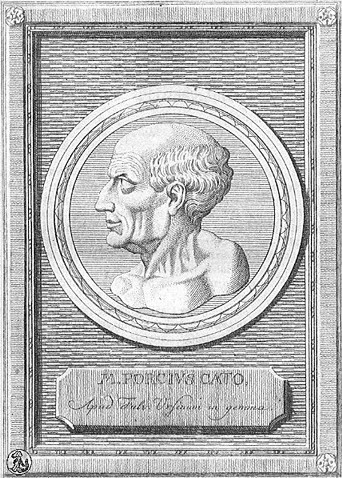 In the Senate Cato spoke out repeatedly against the foreign influences in philosophy, religion, and lifestyle which were encroaching on the traditional Roman attitudes and manners. As a result, Rome’s “smart set” condemned him (privately, for he was too powerful to attack openly) as an archreactionary and an enemy of “progress.”
In the Senate Cato spoke out repeatedly against the foreign influences in philosophy, religion, and lifestyle which were encroaching on the traditional Roman attitudes and manners. As a result, Rome’s “smart set” condemned him (privately, for he was too powerful to attack openly) as an archreactionary and an enemy of “progress.”
In the field of foreign policy, Cato was adamantly opposed to the integration of the Semitic East into the Roman world. He wanted Rome to concentrate on the western Mediterranean and to deal with the Levant only at sword point. Unfortunately, there were few men of Cato’s fiber left among the Romans by the second century.
Declining Birthrate
One of the most fateful effects of decadence was the drastic decline in the birthrate of the Roman nobility. Decadence is always accompanied by an increase in egoism, a shifting of focus from race and nation to the individual. Instead of looking on bearing and raising children as a duty to the state and a necessity for the perpetuation of their gens and tribe, upper-class Romans came to regard children as a hindrance, a limitation on their freedom and pleasure. The “liberation” of women also contributed heavily to this change in outlook.
The failure of the patrician class to reproduce itself alarmed those Roman leaders with a sense of responsibility to the future. Emperor Augustus tried strenuously to reverse the trend by issuing several decrees regarding family life. Heavy penalties were set for celibacy or for marriage with the descendants of slaves. Eventually, Augustus ordered that every noble Roman between the ages of 25 and 60 must be married or, at least, betrothed.
Suicide of the Nobility
In 9 A.D. tax advantages and other preferences were granted to the parents of three or more children; unmarried persons were barred from the public games and could not receive inheritances, while the childless married person could receive only half of any inheritance left to him.
All these measures failed. Augustus’ own daughter, Julia, was a thoroughly liberated member of the “jet set” of her time, who considered herself far too sophisticated to be burdened with motherhood. In embarrassment, Augustus banished her to an island.
From the dictatorship of Julius Caesar to the reign of Emperor Hadrian, a century and a half, one can trace the destinies of 45 leading patrician families: all but one died out during that period. Of 400 senatorial families on the public records in 65 A.D., during the reign of Nero, all trace of half of them had vanished by the reign of Nerva, a single generation later.
Rise of Capitalism
As the patricians declined in numbers, the Roman peasantry also suffered, but for a different reason. The later years of the Republic saw the rise of agricultural capitalism, with wealthy entrepreneurs buying up vast estates, working them with slaves and driving the freeborn small farmers out of the marketplace.
By the tens of thousands the Latin and Sabine yeomen were bankrupted and forced to abandon their farms. They fled to the city, where most of them were swallowed up in the urban mob.
“New Romans”
The capitalist nouveaux riches who came to wield much of the power and influence in Rome lost by the dwindling patricians were an altogether new type of Roman. Petronius’ fictional character Trimalchio is their archetype. Tenney Frank wrote of these “new Romans”:
It is apparent that at least the political and moral qualities which counted most in the building of the Italian federation, the army organization, the provincial administrative system of the Republic, were the qualities most needed in holding the Empire together. And however brilliant the endowment of the new citizens, these qualities they lacked. The Trimalchios of the Empire were often shrewd and daring businessmen, but their first and obvious task, apparently was to climb by the ladder of quick profits to a social position in which their children, with Romanized names, could comfortably proceed to forget their forebears. The possession of wealth did not, as in the Republic, suggest certain duties toward the commonwealth.
Different Spirit
Many historians have remarked on the fact that the entire spirit of the Roman Empire was radically different from that of the Roman Republic. The energy, foresight, common sense, and discipline which characterized the Republic were absent from the Empire. But that was because the race which built the Republic was largely absent from the Empire; it had been replaced by the dregs of the Orient.
The change in attitudes, values, and behavior was due to a change in blood. The changing racial composition of Rome during the Republic paved the way for the unchecked influx of Levantine blood, manners, and religion during the Empire.
But it also set the stage for a new ascendancy of the same Northern blood which had first given birth to the Roman people. We will look at the conquest of Rome by the Germans. First, however, we must backtrack and see what had been happening in the North during the rise and fall of Rome.
Excerpted from the 13th article of William Pierce’s “Who We Are: a Series of Articles on the History of the White Race”:
The Romans were an energetic and martial people, and the power, influence, and wealth which they wielded grew enormously during the period from the end of the sixth to the last quarter of the first century B.C., the life-span of the Republic. First all of Italy, then the rest of the Mediterranean world and the Middle East, and finally much of Nordic Europe came into their possession.
This vast area under Roman rule was inhabited by a great diversity of races and peoples. As time passed, the rights of citizenship were extended to more and more of them. Citizens or not, there was a huge influx of foreign peoples into Rome and the other parts of Italy. Some came as slaves, the spoils of Rome’s victorious wars, and many came voluntarily, attracted by Rome’s growing wealth.
After the Republic became the Empire, in the last quarter of the first century B.C., the flow of foreigners into Italy increased still further. The descendants of the Latin founders of Rome became a minority in their own country. Above all other factors, this influx of alien immigrants led to Rome’s demise and the extinction of the race which built her into the ruler of the world.
Medley of Races
The importance of the immigration factor is, of course, barely mentioned, if at all, in the school history texts being published today, because those who control the content of the textbooks have planned the same fate for White America as that which overtook White Rome.
Nevertheless, the writers of Classical antiquity themselves clearly recognized and wrote about the problem, as do those few of today’s professional historians with courage enough to buck the blackout on the mention of race in history. An example of the latter is the distinguished Swedish historian Martin Nilsson, for many years professor at the University of Lund.
In his Imperial Rome, Nilsson wrote:
Of greater variety than elsewhere was the medley of races in the capital, where individuals congregated from all quarters, either on business with the rulers and the government or as fortune seekers in the great city, where great possibilities were open to all. It is almost impossible for us to realize the extraordinarily motley character of the Roman mob. The only city in our own day which can rival it is Constantinople, the most cosmopolitan town in the world. Numerous passages in the works of Classical authors refer to it, from Cicero, who calls Rome a city formed by the confluence of nations, to Constantius, who, when he visited Rome, marveled at the haste with which all the human beings of the world flocked there…
There were Romans who viewed the population of the capital with deep pessimism. In Nero’s time (37-68 A.D.) Lucan said that Rome was not peopled by its own citizens but filled with the scourings of the world. The Oriental [by Oriental, Nilsson means Levantine, not Mongoloid] element seems to have been especially strong.
The Eternal Jew
Jews, in particular, in order to get their hands on the wealth there, flocked to Rome in such enormous numbers that Emperor Tiberius, under pressure from the common people on whom the Jews were preying, was obliged to order them all deported in 19 A.D. The Jews sneaked back in even greater numbers, and Tiberius’ brother, Emperor Claudius, was forced to renew the deportation order against them a few years later, but without success. They had become so numerous and so well entrenched that the emperor did not have the energy to dislodge them.
Another distinguished historian, the late Tenney Frank, professor at Bryn Mawr and Johns Hopkins, made a careful survey of Roman tomb inscriptions. He studied 13,900 inscriptions, separating them into categories based on the ethnicity or probable ethnicity indicated by the names and corollary evidence. Professor Frank estimated that by the end of the first century A.D. 90 per cent of the free plebeians in Rome were Levantines or part-Levantines. Fewer than ten per cent could claim unmixed Italian ancestry, and of the seven fewer were of pure Indo-European stock.
One problem which Frank ran into was the tendency of non- Italians to disguise their ancestry by changing their names. It was easy enough to separate Greek and Syrian and Hebrew names from Latin ones, but a Latin name which had been adopted rather than inherited could often only be detected by noting the non-Latin names of the parents on the same tomb. Then too, just as Jewish name-changers today often give themselves away by choosing a non-Jewish first name which has become so popular among their brethren that few non-Jews would dream of burdening their own children—with it (Murray, Seymour, Irving are examples), Frank found the same clues among many “Latin” names.
As for the Greek names, the great majority of them did not belong to Hellenes but to Levantines from the remnants of Alexander’s Oriental empire.
C. Northcote Parkinson, the noted author and historian, sums up the effect of centuries of uncontrolled immigration in his East and West (1963): “Rome came to be peopled very largely by Levantines, Egyptians, Armenians, and Jews; by astrologers, tipsters, idlers, and crooks.”
The name “Roman,” in other words, came to mean as little as the name “American” is coming to mean today.
And yet, just as White Americans are bringing about their downfall through greed and timidity and indifference, so did Rome’s patricians cause their own end.
Excerpted from the 13th article of William Pierce’s “Who We Are: a Series of Articles on the History of the White Race”:
Today, when we speak of “Latins,” we reflexively think of short, swarthy, excitable people who are inordinately fond of loud rhythms, wine, spicy food, and seduction, and who aren’t to be taken very seriously. That is not an accurate image of all speakers of Romance languages, of course. Many individuals of French, Spanish, Portuguese, Italian, and Romanian nationality are as racially sound as the average Swede or German. Yet, the image persists, and for good reason.
The Latini, the Northern tribesmen who settled Latium in the ninth century B.C. and founded Rome a century later, were something altogether different. Most of today’s Latins share nothing with those of 28 centuries ago except the name. Not only are the two strikingly different in appearance and temperament, but every element of the culture the original Latins created as an expression of their race-soul has been fundamentally transformed by those who claim that name today.
Even the character and tone of the modern languages derived from that of the Latini are profoundly different. The Romance languages, overburdened with vowels, have a soft, effeminate air that was never present in the language of the early Romans, which was as hard and manly as the people themselves. (The Romans did not say See-sar or Sis-ero; they said Kai-sar and Kick-ero.)
Virtuous Race
Above all, the Latini were a people to be taken seriously. They brought with them to Italy the spirit of the northern forests whence they had come. They took themselves and life very seriously indeed.
Duty, honor, responsibility: to the early Romans these were the elements which circumscribed a man’s life. Their virtues (the Latin root of the word means “manliness”) were strength of body and will, perseverance, sobriety, courage, hardiness, steadiness of purpose, attentiveness to detail, intelligence, and the characteristically Nordic will to order. Through these virtues they brought the world under their sway and created a civic edifice of such magnificence that it has ever since provided the standard against which all others are measured.
The Romans shaped the world around them—its institution, its politics, its attitudes, and its lifestyles—more extensively and more profoundly than anyone else has, and then they perished. That fact has fascinated and occupied the energies of historical scholars as no other topic. What were the reasons that the Romans rose so high and then fell so far?
Typically Indo-European
When they arrived in the Italian peninsula in the ninth century the Latins, like their Italic neighbors before them, brought with them institutions and customs which were typically Indo-European. In a great many ways they remind us of the Mycenaean Greeks described by Homer. In the social and political institutions of the early Romans, in particular, we can see elements which were as familiar to the Dorians three centuries earlier as they were to the Celts and Germans ten centuries later. Just as the languages of all these kindred Northern peoples were derived from a common source, so were their modes of organizing and governing themselves.
The earliest history of the Romans is partly shrouded in the mists of antiquity. The Latins were not as fond of writing books as were the Greeks, and only a few inscriptions in stone have come down to us from the time prior to the fifth century B.C.—and not a great deal after that, until the second century B.C. The oral traditions of the Roman people from the eighth century B.C. are a blend of myth and history and must be taken cum grano salis, as they would have said.
Latins, Sabines, Etruscans
Very early in its history, Romulus’ hilltop village of Latins joined forces with a neighboring village of Sabines, the Titienses. The Sabines and the Latins were of very closely related Indo-European stocks, and the amalgamation did little to change social institutions, other than doubling the number of senators.
A few years later, however, the Etruscan Luceres—of non-Indo-European stock—were absorbed by the growing Rome. Although the Etruscans remained a tribe apart from the Latin and Sabine inhabitants of the city, without patrician status, this condition was destined not to last.
Kings of Rome
Tradition gives the date 716 B.C. for the death of the Latin founder of Rome, Romulus. He had long before carried out the amalgamation of his tribe with the Titienses, and a year after he died the combined Latin-Sabine populus chose a Sabine, Numa Pompilius, as the second king of Rome.
For a century the kingship alternated between Latin and Sabine, but about the year 616 B.C. it passed to a man who was neither. He was Tarquinius Priscus (Tarquin the Elder) and was said to be the son of a Greek father and an Etruscan mother. How a half-Etruscan came to be king of the Romans is not clear; the traditional account is not convincing.
Probably what happened is that Rome suffered a military defeat at the hands of one of the powerful Etruscan communities on the other side of the Tiber. In any event, Tarquin forced the Romans to accept 100 new patrician families from among the Etruscan inhabitants of the city. Although the Etruscan patricians were accorded a status subordinate to that of the elders of the Latin and Sabine clans (the former were designated patres minorum gentium, or “fathers of the lesser clans”), time eventually blurred this distinction; the Etruscans entered the Senate, bringing the number of senators to 300, where it remained for more than five centuries, until the dictatorship of Julius Caesar.
Servian “Reforms”
It was Tarquin’s successor, Servius Tullius, however, who wrought changes which were to have much more profound racial consequences: in essence, Servius made the plebs a part of the populus Romanus. He accomplished this by overshadowing the patrician assembly, the Comitia Curiata, with two new popular assemblies, one civil and one military.
Gold over Blood
Servius certainly cannot be accused of being a democrat. Yet he clearly initiated the process which eventually led to the ascendancy of gold over blood in Roman society, just as Solon had done in Athens a few years earlier.
Four Factors
The following centuries saw the political power of the plebs increase greatly relative to that of the patricians, while wealth continued to gain weight relative to race and family.
The Romans survived the founding of the Republic by roughly a millennium, but we are not concerned in this series with the political and cultural details of their history, except as these details have a salient racial significance. Therefore, the emphasis in the following historical summary is rather different than that found in most textbooks on Roman history.
Let us focus on four factors: first, the growing racial diversity of the Roman state; second, the eventual decadence of Rome’s patricians; third, the differential in birthrates between Rome’s patrician and plebeian classes; and fourth, the effects on the Roman peasantry of large-scale slavery as a capitalist institution.
This text has been merged within another entry (here)
